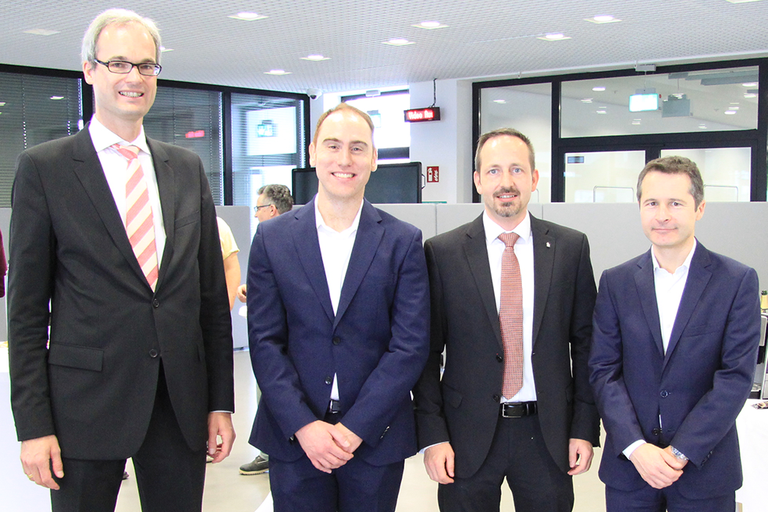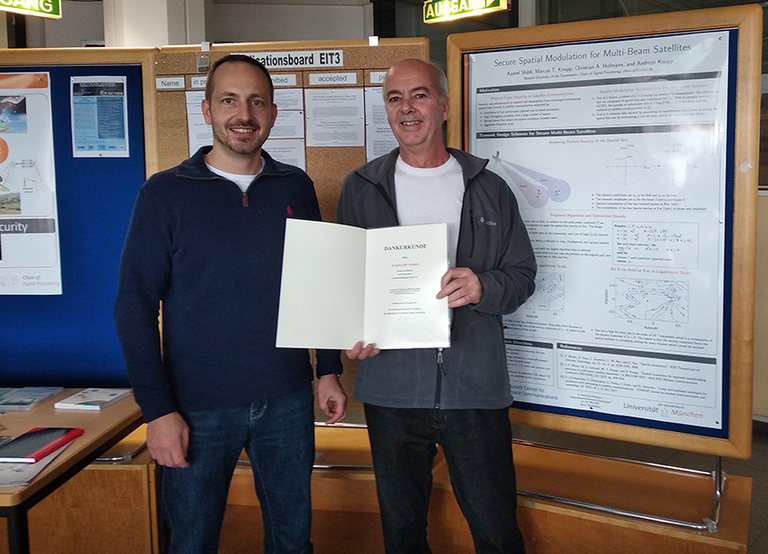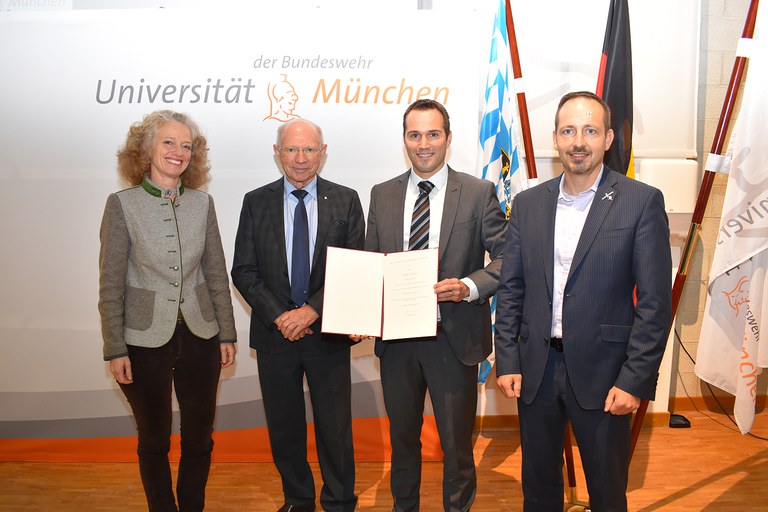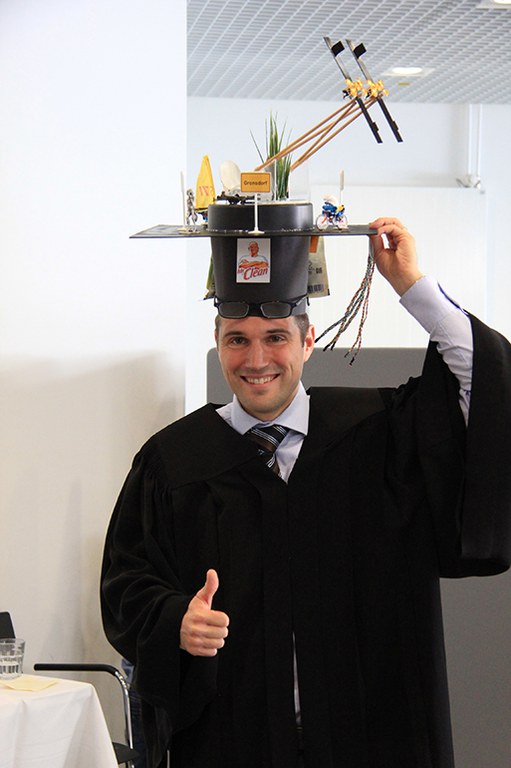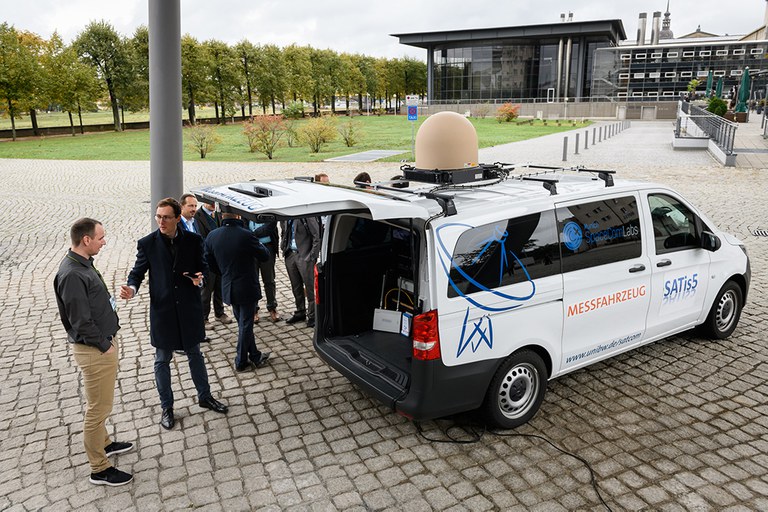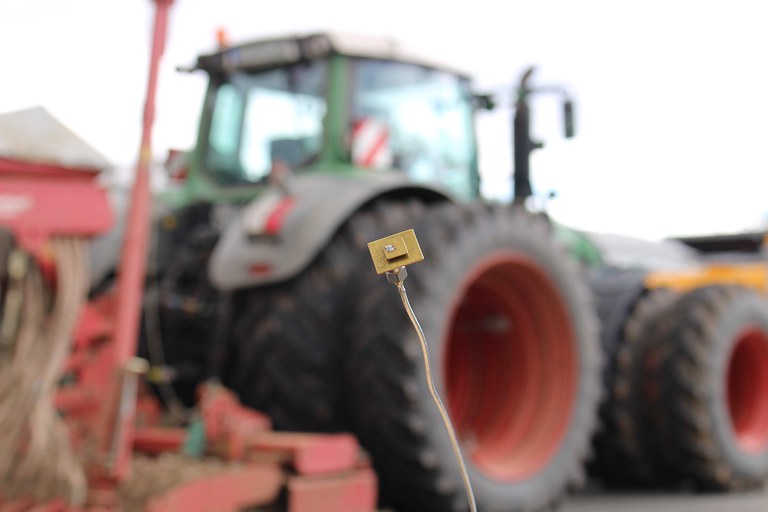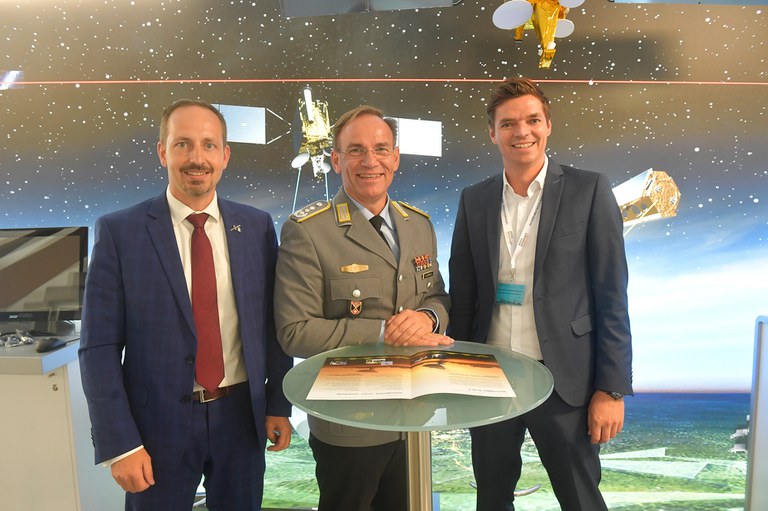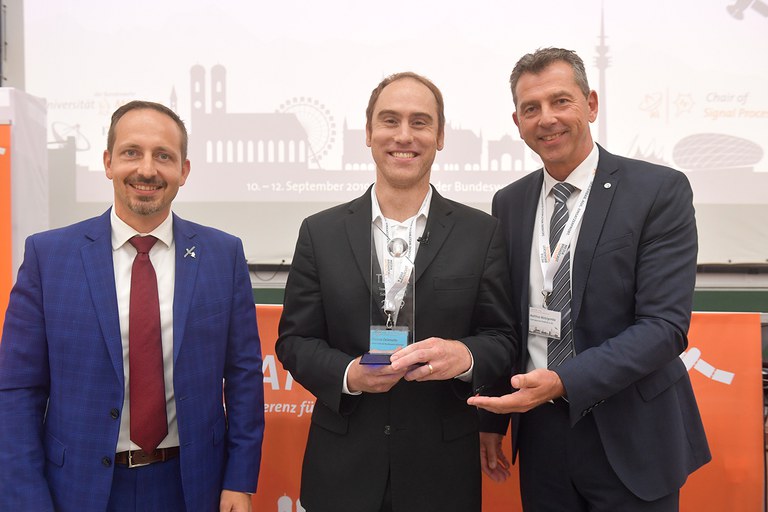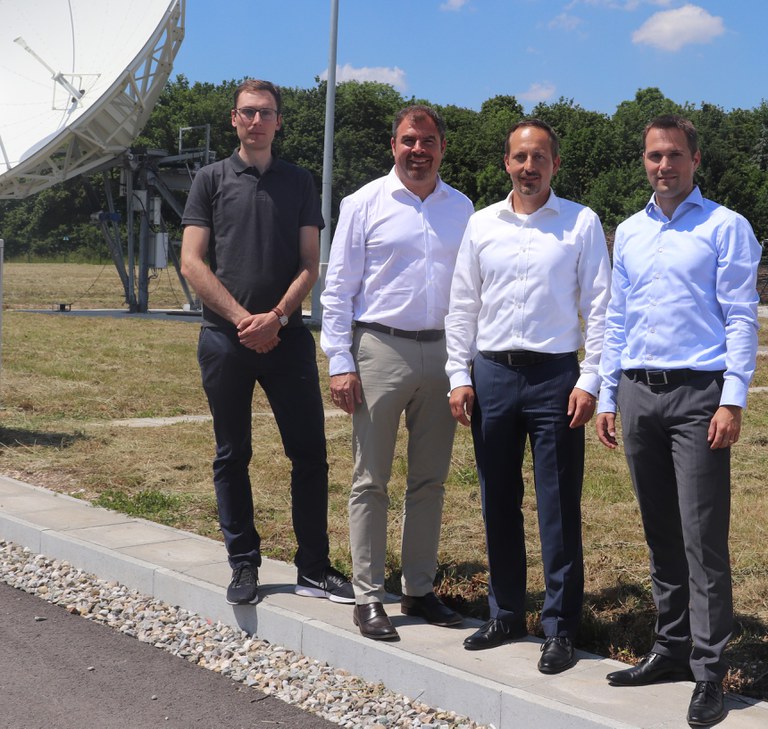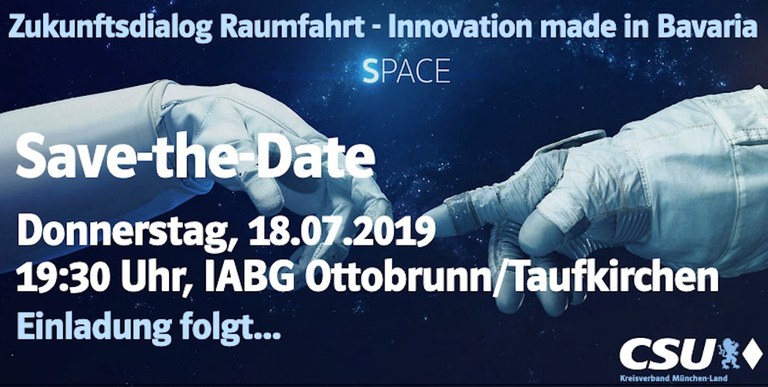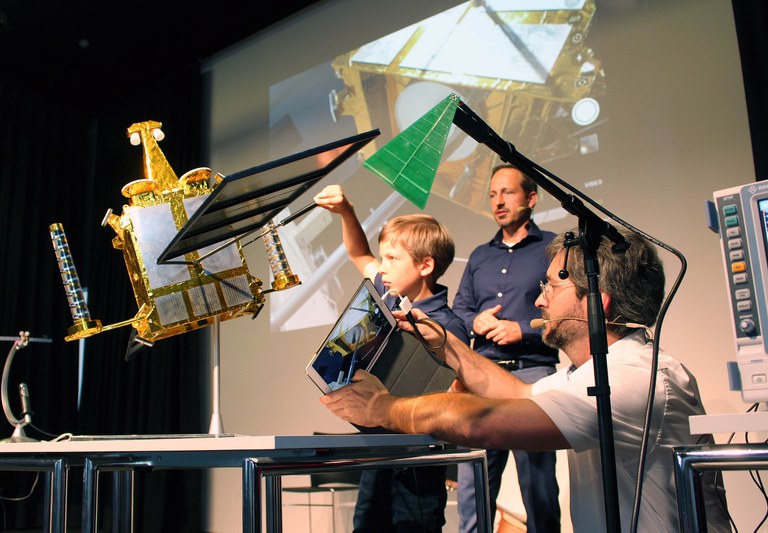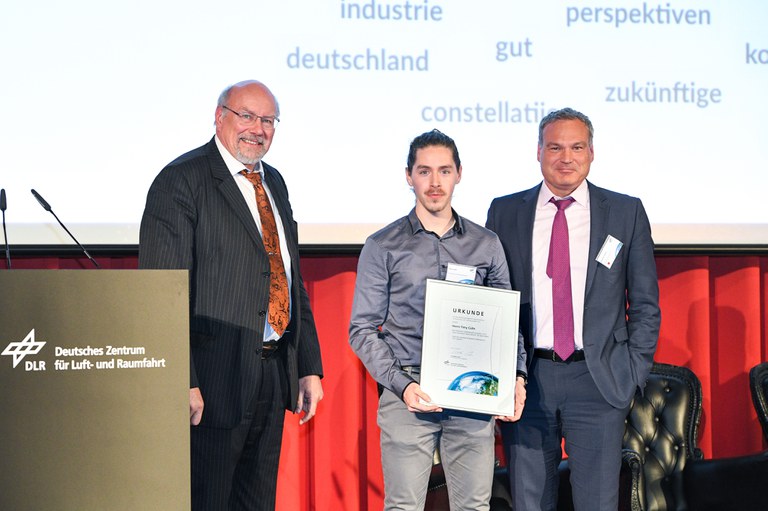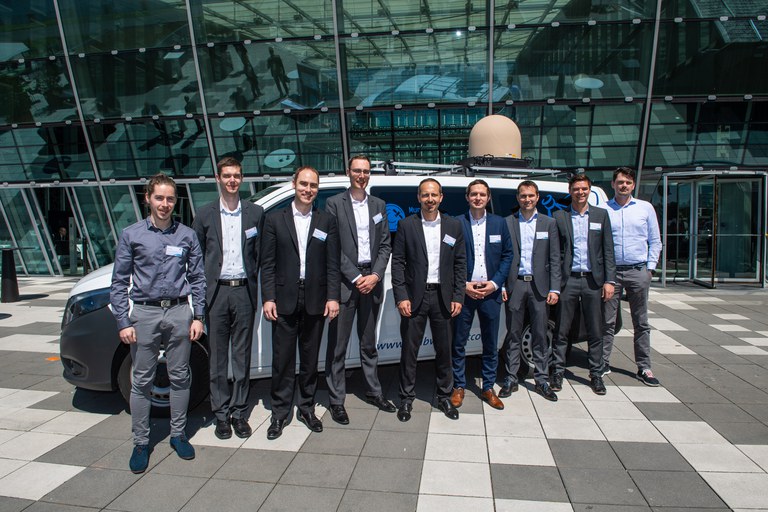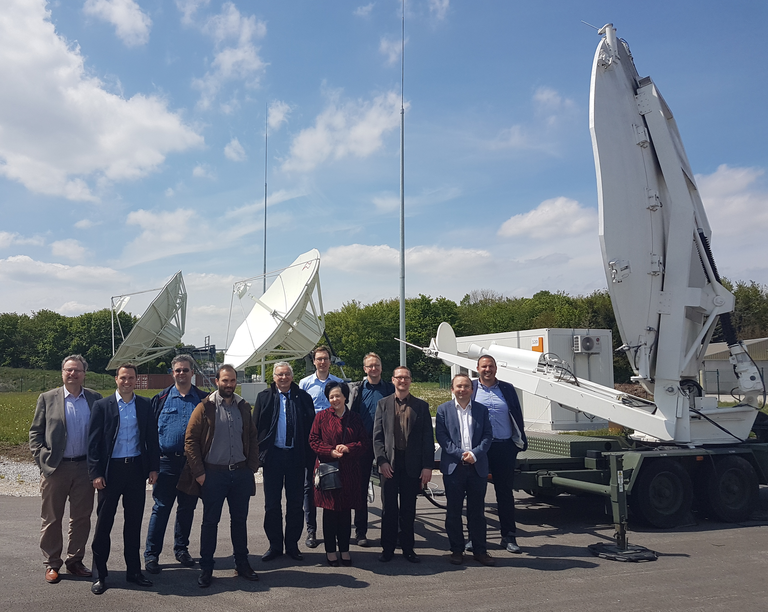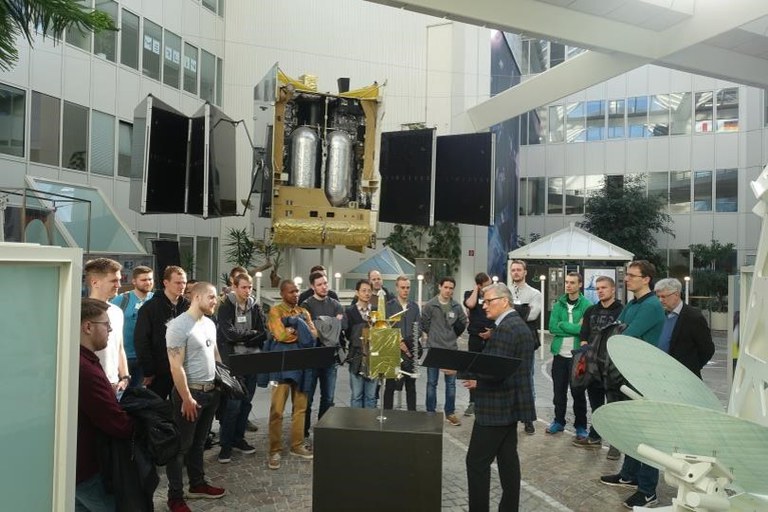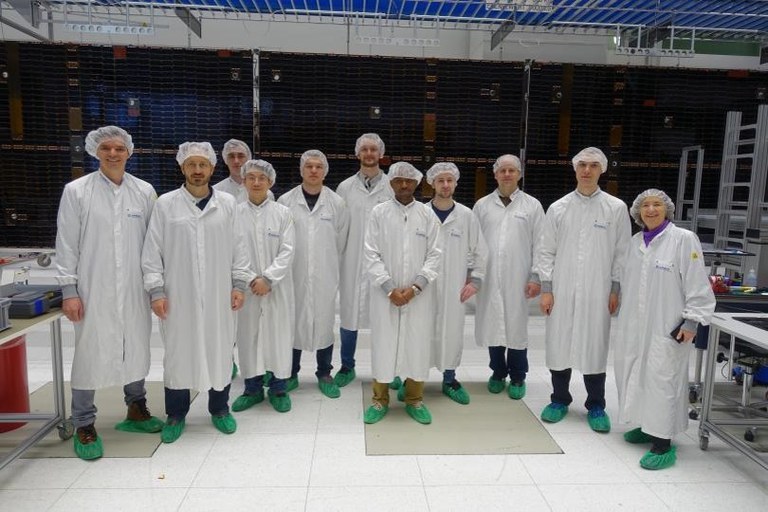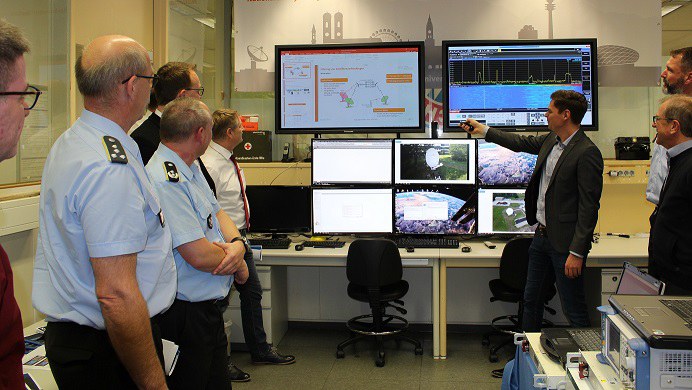| newer News / older News |
|
Thomas Delamotte promoted to "Dr.-Ing." Mr. Delamotte has successfully defended his doctoral thesis entitled „MIMO Feeder Links for Very High Throughput Satellite Systems“. Building upon the Multiple-Input-Multiple-Output (MIMO) technology for satellite communications, which has been developed by the Chair of Signal Processing, his groundbreaking work lay the foundation of a new approach to address the major challenges encountered in the design of Earth-to-space links (feeder links) for next-generation geostationary satellite systems.
Based on his excellent contribution and his outstanding performance in the final qualifying examination, Mr. Delamotte convinced the jury (Chairman: Prof. Rainer Marquardt / Examiners: Prof. Carlos Mosquera, University of Vigo; Prof. Gerhard Bauch, Hamburg University of Technology; Prof. Andreas Knopp) which awarded him his doctoral degree with the highest distinction (summa cum laude). |
|
Wolfgang Weber retired November 30, 2019: After 43 years of excellent work, our employee Wolfgang Weber has retired today. For this reason we presented him with his certificate and toasted with him. We all thank him for the great time we had with Wolfgang and are very happy that he will continue to support us. Many thanks, Wolfgang!
|
|
Research Award for Outstanding Dissertation: After successful defense of his Ph.D. thesis about MIMO Satellite Communications, Robert Schwarz received the University’s prestigious annual “Research Award for Outstanding Dissertations” on October 25th, 2019. This award has been sponsored by the University’s “Circle of Friends and Patrons” to encourage and reward excellent scientific contributions to the field of engineering. The awards ceremony took place during the annual “Dies Academicus” celebration of the Bundeswehr University Munich. Prof. Dr. Eva-Maria Kern, Vice President of Research Activities, highlighted in her laudatory speech the perfect match between challenging theory and practical usability of Robert’s scientific contribution. The main idea of his approach is to combine multiple spatially distributed ground and satellite antennas by forming a virtual multiple-input multiple-output (MIMO) system. This way, the throughput of future satellite systems can be increased while maintaining the system cost level. This means that the costs per bit transmitted can be dramatically reduced. “I am very proud especially because we belong to the first researchers in the world who proposed the application of the MIMO technology to fixed satellite networks. Having started in 2008, we went through all steps from fundamental research to validation, field trials and practical demonstrations. With the foundation of the University’s spin-off company NEOSAT in 2018, we will now bring our innovation to maturity. The next generation of Very High Throughput Satellites (VHTSs) will for sure be MIMO satellites”, Robert commented the great success story about the research on “MIMO over Satellite” at the Bundeswehr University Munich.
|
|
Robert Schwarz promoted to “Dr.-Ing.” Ph.D. candidate Robert Schwarz has successfully defended his pioneering dissertation on MIMO Satellite Communications Concepts. With an excellent presentation and a rigorous exam he convinced the jury of his talent and ability to conduct meaningful and professional research. The jury, which was formed of Prof. Berthold Lankl (chairman) and the examiners Prof. Angeles Vazquez-Castro (Autonomous University of Barcelona, Spain) and Prof. Andreas Knopp, awarded the Dr.-Ing. degree with the best possible rating “summa cum laude” (with distinction). Congratulations to Dr. Schwarz, well done!
|
|
5G World Forum – Satellite Technology for the 5G Era On October 1-2, the IEEE Future Networks Initiative hosted its second 5G World Forum (5GWF) conference in Dresden, Germany. Being the flagship conference of IEEE’s society-overarching initiative on the next generation of mobile communication networks, the 5GWF is among the most important venues to present core technologies and cutting-edge results. For the first time, the event hosted a dedicated workshop on satellite and non-terrestrial networks for 5G. bringing together researchers and practitioners of both ecosystems, the satellite community and the terrestrial mobile network community. This workshop has been organized and led by Prof. Andreas Knopp as its General Chair, and by Dr. Siegbert Martin (CTO of Backnang based TESAT Spacecom GmbH) as well as Dr. Marc Hofmann (program manager for 5G activities in the German Aerospace Center (DLR), Space Administration) as the program co-chairs. With 14 scientific paper presentations, an industry panel discussion, and two major demo cases, the workshop gained enormous interest in both of the addressed communities. Especially the panel, which was organized and vividly moderated by Dr. Marc Hofmann, shed light on different views on the roles and potential contributions of satellite in a 5G ecosystem. Since the panelist came from terrestrial network supplier Ericsson, the satellite MNO SES, the European Space Agency, and the satellite ground equipment supplier Newtec, heterogeneous views on the pros and cons of satellite were lively discussed.
The demo cases performed by our research center covered two important aspects and use cases for satellite in 5G. The first use case, which has been developed and presented by research associate Florian Völk, showed major results of the ESA funded prototyping study SATIS 5. In particular, a mobile 5G edge node (see foto) was set up to present various features where satellite can contribute to the success of 5G for ubiquitous service to everybody. The second use case, which has been developed and presented by Prof. Christian Hofmann, was dedicated to machine-type communications and sensor data transmission in an agricultural context. The demo showed a miniaturized satellite antenna to uplink narrowband sensor information to GEO satellites, relaying this information into a smart farming network. For that purpose, the sensor was equipped with a proprietary waveform developed at our institute that shows unique power efficiency and robustness features for very tight link budgets. Altogether, the event was extremely valuable and successful to demonstrate and discuss the enormous societal impact that satellite technologies can make when integrated into an upcoming 5G ecosystem. In this context, we were again able to demonstrate and stress our ambition to be among the pioneering institutions for satellite communications technology worldwide. More picture here. |
|
Internet-of-Things via Satellite for Applications in Agriculture Space-based solutions are an important part of successful, efficient and future-oriented agriculture. On October 1st, we successfully performed a demonstration in the context of the „5G & Digital Farming Conference” at an experimentation field in Köllitsch which is part of Saxony’s “simul+ InnovationHub”. We were able to show that our very small sensor for Internet-of-Things applications can communicate via satellites in the geostationary earth orbit. The audience was convinced that this solution can deliver useful services to agriculture in rural areas without terrestrial communication infrastructure.
|
GOSATCOM 2019 – a Successful Follow-On From September 10-12, the Chair of Signal Processing has hosted the GOSATCOM 2019 – the 3rd National Conference on Governmental Satellite Communications. An audience of 180 experts from academia, government and industry discussed on the pros and cons of increased standardization efforts with respect to governmental and military satellite communications technology. Guidance was given by two excellent keynotes. Colonel Marcus Schleiermacher, Head of Division Communication and Information Services in the IT Operation Command of the German Armed Forces, explained the importance of interoperability in multinational theaters. Commercial aspects and chances of standardized technology was highlighted by Prof. Ingo Viering, Managing Director of NOMOR, an SME that has been strongly involved into 5G standardization efforts. From the scientific perspective, besides numerous talks and poster presentations, a highlight was the presentation of the Tesat Spacecom Science Award 2019. Thomas Delamotte, a PhD student of Prof. Andreas Knopp, received the 2019 award, which is sponsored biannually by the market leader for satellite communication payloads Tesat Spacecom GmbH, for his dissertation on Multi-Antenna Feeder Links for High Throughput Satellites. Since the award is dedicated to strong innovations with high practical applicability, we are proud that the research performed at our institute has been recognized for its potential to create societal impact.
|
Tesat Spacecom Science Award 2019 September 11, 2019 Thomas Delamotte, a PhD student of Prof. Andreas Knopp, has received the Tesat Spacecom Science Award 2019 for his PhD thesis entitled „MIMO Feeder Links for Very High Throughput Satellite Systems“. This prize is granted biannually by the market leader in the field of satellite payload equipment, Tesat Spacecom, for scientific innovations with high practical applicability. In his research works, Thomas Delamotte has developed a novel multi-antenna feeder link architecture to address the bandwidth bottleneck encountered in current high throughput systems. To guarantee a high link availability, his solution also includes advanced diversity schemes to mitigate strong rain fades in the frequency bands (e.g. Ka/Q/V-bands) currently used for feeder links operation. The proposed multi-antenna approach represents a serious alternative to other candidates for future system designs such as optical feeder links.
|
|
Forschungsanlage Munich Center for Space Communications an der Bundeswehruniversität June, 2019: Der örtliche Bundestagsabgeordnete Florian Hahn besichtigte die derzeit größte und leistungsfähigste universitäre Forschungsanlage für Satellitenkommunikationsexperimente in Deutschland an der Universität der Bundeswehr München in Neubiberg. Genutzt wird die Anlage insbesondere für komplexe Experimente an geostationären Kommunikationssatelliten sowie für Geräte- und Systemtests, bspw. im Rahmen von Beschaffungsprojekten der Bundeswehr, erläuterte Lehrstuhlinhaber Professor Andreas Knopp beim Rundgang. Hahn lobte diese Besonderheit gerade für etwaige Kooperationen im Rahmen der bayerischen Luft- und Raumfahrtstrategie sowie für die zahlreichen Raumfahrtunternehmen im Landkreis München.
Hahns Fazit: "Der Lehrstuhl von Professor Knopp zählt zu den ersten Adressen, wenn es um Forschung zur Weltraum- und Satellitenkommunikation geht und ist kompetenter Ansprechpartner für die Bundesregierung und ihre Ministerien. Es ist beeindruckend und europaweit einmalig, was hier an der Bundeswehruniversität über Jahre aufgebaut wurde. Eindeutig ein Wettbewerbsvorteil für das Forschungsumfeld." Zugleich kündigte der Politiker an, anlässlich 50 Jahre Mondlandung einen Zukunftsdialog zur Raumfahrt am Donnerstag, 18. Juli 2019, in den Räumlichkeiten der IABG zu planen. |
Lecture on satellite broadcasting for elementary school kids June 22, 2019: A very special audience of 169 elementary school kids, partially accompanied by about 80 parents, enjoyed a university lecture on satellite broadcasting technology last weekend. The lecture was held upon invitation by the county commissioner of the Vogtlandkreis. It was given by Prof. Andreas Knopp and his brother Dr. Marcus Knopp, who is with the German Space Operations Center (GSOC) at German Space Agency (DLR). Starting with the basics of radio waves for information transmission, the lecture explained the purposes of communication satellites as well as the fundamentals of satellite technology, orbit mechanics, and in-orbit transfer of the spacecraft. A lot of experiments were conducted to involve the kids into the lecture. So-called “children’s university” programs have gained high attention in Germany in order to stimulate interests for academic disciplines at early stages of the children’s education already.
|
Award „Next Generation meets Satcom“ May 15, 2019: Dipl.-Ing. Tony Colin has been honoured with the award “Next Generation meets Satcom”, at the 6th biennial “German National Conference on Satellite Communications” in Bonn, Germany. More than 300 experts from industry, government, and academia were invited to give their vote for the most relevant and trendsetting technology under the motto “satellites in future communication networks”.
The competitors had to present their topics and ideas in a three-minute pitch in front of the audience, followed by the two-day conference where the voters were able to ask questions and discuss. In this context, the work presented by Tony Colin, selected among 19 proposals and entitled “Machine Learning for Resource Allocation in High Throughput Satellite Systems”, tackles the potential role that machine learning could play in future satellite systems. Through its adaptivity, learning capability and low complexity, machine learning appears now as a key enabling technology to improve further the utilization of satellite resources and the capacity distribution to the users. Note that this award has been generously sponsored by Dr.-Ing. Walther Pelzer, Member of the DLR (German Aerospace Center) Executive Board and Head of the DLR Space Administration. |
6. German National Conference on Satellite Communications May 14-15, 2019: The “German National Conference on Satellite Communications”, held in Bonn’s Kameha Grand Hotel, gathered more than 300 experts from industry, government, and academia to discuss, under the motto “satellites in future communication networks”, the opportunities and challenges in the satellite sector.
We have been very glad to participate at this event under different qualities:
We would like also to thank Wolfgang Hanzl, Thomas Delamotte that were a great help for the organisation. This event has been great opportunity to meet and discuss with our partners, customers and supporters. We are looking forward to participating in the next National Conference! |
|
SATis5 April 2019 – Satellites will improve 5G systems by making them more agile, smart and robust. Therefore, the role of satellites and non-terrestrial networks needs to be investigated for the provision of the main use case areas of 5G systems. The development of a convergent satellite-terrestrial architecture, tailored to the satellite capabilities and to the targeted use cases is one of the key challenges. The European Space Agency (ESA) funded Demonstrator for Satellite-Terrestrial Integration in the 5G Contex (SATis5) project deals with the key question of the integration of satellites into a large-scale 5G Europe-wide testbed with access to satellite over-the-air demonstration capabilities.
The Chair of Signal Processing hosted the 3rd Milestone meeting of this ESA 5G flagship project on Tuesday 07/05/19. The current status of the testbed development has been presented to the ESA Project Officer Dr. Maria Guta. In addition to the testbed development updates the antenna facilities of the Munich Center for Space Communications which includes the novel antenna site on the UniBw Campus with access to the main satellite frequency bands were presented by the Chair of Signal Processing. The Newtec Dialog Hub platform will be hosted by Mai 20th on the UniBw Campus as one of the main communication nodes of the SATis5 testbed. More or less the complete over the air communication of the SATis5 testbed will be controlled by the Hub platform which is directly connected to our earth station until the end of the project duration in September 2020. |
|
AIRBUS Space TechDay – visiting our neighbors in Ottobrunn March 20, 2019: A group of interested students visited AIRBUS during an excursion organized by the Chair of Signal Processing. During the program they have been introduced to the history of space in Ottobrunn and the Bundeswehr’s COMSATBw satellites. In guided tours through the ARIANE production, the Antenna test site, the Solar panel production and EDRS Mission Operation Center the students were able to get in touch with SATCOM facilities and get impressions that deepen the topics of their lectures on space communications.
Many thanks to the team at Airbus for a perfectly organized and very exciting day. We hopefully created some new space enthusiasts who will pursue a career on space topics – either in industry or within the Bundeswehr. |
|
Protecting our Military Satellite Communications March 2019 – The Chair of Signal Processing supports the Bundeswehr to protect their satellite communication systems. During an over-the-air test using one of the German military communication satellites, Jun.-Prof. Christian Hofmann gave insight into the topic of satellite jamming. The audience was able to see different satellite modem platforms in action with different techniques to increase the robustness against jammers. We were able to show that our test center (SatCERTBw) is able to handle complex over-the-air hardware tests and has outstanding measurement equipment for in-depth hard- and software performance analysis. With this demonstration a major three-years study on protected satellite communication, led by Christian Hofmann, came into its final phase. The study had been awarded to us by the BAAINBw with the aim to prepare the military SATCOM systems for electromagnetic protection in an increasingly complex threat scenario.
|
| newer News / older News |
News 2019

